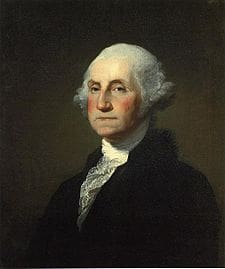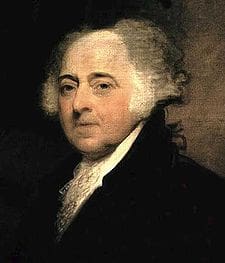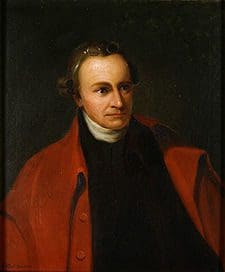
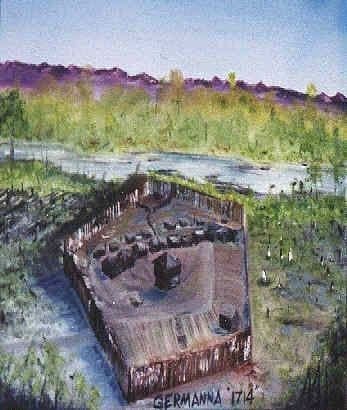
One of the consequences of having roots in Madison County, Virginia is the strong likelihood of finding ancestors in the Germanna immigrant community. The history of the Germanna immigrants is a fascinating look back into the early days of the United States and Virginia in particular. The German settlers that came to Virginia as part of the Germanna community were settled in the Virginia frontier by Virginia's Royal Lt.
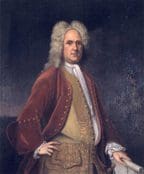
One of the consequences of having roots in Madison County, Virginia is the strong likelihood of finding ancestors in the Germanna immigrant community. The history of the Germanna immigrants is a fascinating look back into the early days of the United States and Virginia in particular. The German settlers that came to Virginia as part of the Germanna community were settled in the Virginia frontier by Virginia's Royal Lt.
Governor, Alexander Spotswood. The name Germanna reflected both the German immigrants and the British Queen, Anne, who was in power at the time of the first settlement at Germanna. Though she was to die only months after the Germans arrived, her name continues to be a part of the area.
The Oddenino family finds multiple lines in the Germanna community. Some of this information may be found on individual pages in this site and at the risk of some repetition, I am putting all the Germanna information on this page to allow a more centralized view of this fascinating history. But first let's take a look at the European history that led to the immigration to Virginia.
Historical Background of the German Immigration:
Why were the Germanna immigrants Lutheran? Or were they?
Not all the Germanna people were Lutheran - just the second colony group of 1717. The first colony group of 1714 was German Reformed. While they are both under the Evangelical title today in Germany, they were not together then. The Siegen area had no Lutheran churches at the time our ancestors were living there. The Siegen area was under the control of The Netherlands and influenced by the Dutch Reformed Church which was strongly anti-Catholic. The forms of worship as well as the music was quite different between the Lutheran and the German Reformed churches.
Understanding a little of the historical context of our ancestors can make genealogical work even more satisfying. For example, the threads of history that are woven into the Germanna immigrants to Virginia story, actually begins with the Renaissance popes.
During the Renaissance, the papacy was attempting to strengthen its position as the international leader of the faith. To gain support, the papacy cut deals with various monarchs of France, Spain and England whereby those monarchs would support the papacy in Rome on spiritual matters in exchange for the monarchs’ ability to select archbishops, bishops and other church officials in their respective countries. Also, the funds derived from church properties in those countries would be shared with those monarchs.
No such deal was made with Germany as there was no powerful central leader in Germany at that time. Thus, Germany continued to have the church officials selected by the papacy leading to German dissatisfaction over the number of foreigners in their country running the church as well as the large flow of church funds out of Germany. The popular sentiment against these foreigners and church policies provided a fertile ground for Martin Luther’s reformation ideas.
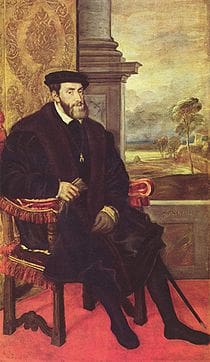
Lutheranism spread throughout Germany in the early 1500s. When Charles V became the Holy Roman Emperor (essentially the ruler of Germany) he was already the King of Spain and had other holdings throughout Europe. With Charles V’s attention primarily fastened on other countries, little was done to stop the spread of Lutheranism in Germany. In 1526 Charles V needed help from the Lutheran princes in Germany for his war in Italy against the French. To obtain Lutheran support, Charles V conceded the legal right for Lutheranism to exist in Germany.
Charles V was of the ruling Habsburg family which maintained a lengthy international contest with the French Valois family. This conflcit between these two ruling dynasties ignited the Italian Wars. Charles V's preoccupation with the wars in Italy contributed to the growth of Lutheranism in Germany.
(Historical note: The Lutheran Princes weren't the only ones assisting Charles V's campaign in Italy. Pope Clement VII, of the Medici family, maintained a virulent dislike of the Borgia family. A prior Pope, Alexander VI, was the father of the famous Lucrezia Borgia. Lucrezia was married to Alfonse d'Este of Ferrarra. Clement VII took hostile actions against the rule of Alfonse primarily owing to the fact that Alfonse was married to a Borgia. Subsequently, Alfonse joined with Charles V to help sack Rome and humiliate Clement VII.)
After a successful campaign in Italy, Charles V later attempted to reverse his previous concessions to the Lutherans. The Lutheran delegates walked out in protest at a general assembly in Speyer, Germany thus earning the name of Protestants. The successful campaign of Charles V in Italy had other consequences which could hardly have been foreseen at the time.
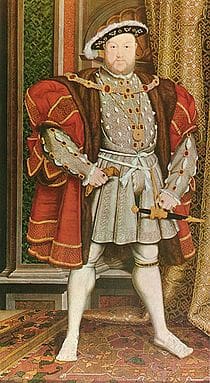
In 1529, during the period that Charles V dominated in Italy, King Henry VIII of England sought from the Pope an annulment of his marriage to Catherine of Aragon. Pope Clement VII, however, was a virtual prisoner of Charles V, a nephew of Catherine of Aragon. Charles V refused to allow Pope Clement VII to grant Henry VIII the annulment. Henry VIII's minister, Cardinal Wolsey, was helpless to secure the divorce from the Pope in such circumstances. This led to Henry VIII's split with the Catholic Church and his marriage to Anne Boleyn. The only child of Henry VIII and Anne Boleyn was Elizabeth I, who became one of England's greatest monarchs and after whom the state of Virginia was named (Elizabeth, the Virgin Queen).
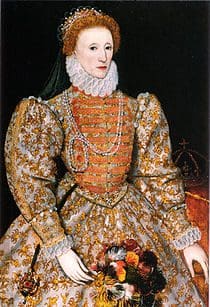
Another footnote to history: It was Charles V and his wife Isabella who gave Francisco Pizarro the exclusive right to conquer Peru. It was on November 16, 1532 that Pizarro and his fellow conquistadores captured the Inca ruler Atahualpa after which events led to the ultimate Spanish conquest of Peru and large additional revenues to Charles V. Participating in the conquest with Pizarro was Hernando de Soto who would later make a name for himself in North America.
Charles V peeled off Spain and the Netherlands in 1556 for his son Phillip II to rule. (The Philippines were named after Phillip II). Phillip II married Queen Mary aka Bloody Mary, the daughter of Henry VIII and Catherine of Aragon. This was a very unpopular marriage in England with considerable resentment over the sense that English interests were being supplanted by Spanish interests. When Mary died without issue in 1558 and Elizabeth I came to the throne, Spanish and Catholic power in England waned significantly.
Phillip II wanted to marry Elizabeth to continue Spanish hegemony with England but Elizabeth, a staunch protestant, wanted to restore English independence and distance the country from papal authority. Phillip II did not take rejection well and his desire to return England to the Spanish fold ultimately resulted in the ill-fated episode of the Spanish Armada in 1588.

An interesting colonial American footnote to this story is that the Roanoke Colony settlers were expecting more provisions from England when a ship left the colony in 1587 with plans to return. (The first English child born in America, Virginia Dare, was born in 1587 on Roanoke Island.) The war with Spain, and the need for all English ships to be marshaled to meet the Spanish Armada, resulted in no ships being sent back to the Roanoke Colony until 1590 at which time everyone was gone. This enduring mystery of what happened to the settlers of the Roanoke Colony remains the subject of inquiry and speculation today.
Now back to the early 1500s. Not long after securing power in Italy, Charles V had other enemies to deal with in the form of the Ottoman Turks who were menacing the gates of Vienna. In 1532 Charles V again granted Lutherans the legal rights they previously enjoyed and with the aid of Lutheran forces Charles V defeated the Ottoman Turks.
Religious conflict continued to plague Germany throughout the European religious wars down to the Thirty Years War which ended in 1648. Germany was in tatters after all these wars and our German ancestors were still reeling from the wars’ economic effects when they finally looked to America as a place to begin anew.
The Thirty Years War:
In 1607 a handful of English settlers arrived in Virginia to begin the first permanent English settlement in the New World - Jamestown, Virginia. Previous English explorers such as Sir Walter Raleigh traveled to the New World and while they didn’t remain, they did confer the name of Virginia on this new territory, after the Virgin Queen, Elizabeth I. We’ve all heard the stories of Captain John Smith, Pocahontas, and the difficult early days of this first Virginia settlement. And while Virginia was experiencing its difficult early days, Germany was still awash in religious turmoil.
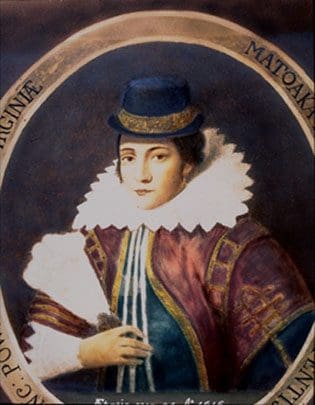
In 1619, just twelve years after the establishment of Jamestown, Ferdinand II became the Holy Roman Emperor. Remember, the name Holy Roman Empire was a title that bore little resemblance to reality and in 1619 it consisted primarily of the German territories. Voltaire’s description of the Holy Roman Empire as 'neither Holy, nor Roman, nor an Empire' exposes the inaccurate label. Also, after Charles V gave Spain and the Netherlands to his son Phillip II to rule in 1556, there was even less basis for the name. The remaining German territories were ruled by Ferdinand II. Thus, I refer to the area ruled by Ferdinand II as Germany, though not with the modern borders we know today, as it still gives a more accurate picture than the title it actually bore.
The uneasy religious peace in Germany was shattered in 1618 with the onset of the Thirty Years War. Ferdinand II was another militant Catholic counter-reformation leader who revoked many of the concessions earlier granted to Protestants. Ferdinand II sent envoys to the Bohemian capital of Prague to advise them of these new laws. His ministers were not well-received to say the least. They were summarily thrown out a fourth-story window to their death. (The word defenestration finds its roots in this action). The war was on. The Protestants in Bohemia sought troops from other Protestant states such as the Dutch and the English but only received some monetary aid. Frederick, the Elector of the Palatinate, was made the King of Bohemia, which proved to be such a short tenure as to earn him the title of the “Winter King.”
Ferdinand II crushed the Protestant forces in Bohemia and then flooded the territory with Catholic forces. The Jesuits were brought in, as were many armed troops. Spanish Catholic troops took over the Palatinate. Soon Catholic troops were moving into northern Germany to establish control there as well. This then led the Danish to enter the fray, with no small amount of encouragement from England, the Netherlands and France. Why Catholic France? The French maintained an historical animosity against the Hapsburgs and their political interests overrode their religious ones.
The Danish army was defeated owing in large part to the brutal warfare waged by Albrecht von Wallenstein. Though working for the Holy Roman Emperor, Wallenstein did not pay his soldiers but allowed them to pillage and plunder their way through Germany. This approach paid no heed to whether they were looting friend or foe. Germany was being gouged by this war. After the defeat of the Danish, more Catholic power was flexed including the issuance of an order that all land the Protestants had taken from the Catholic Church would have to be returned. This meant the virtual destruction of the Lutheran princes if it were to be carried out. Protestants determined to continue the fight.
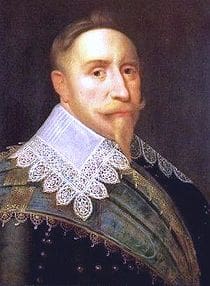
The Swedish army was then enticed into the war, again by the English, Dutch and French. Sweden also coveted territorial gains on the Baltic coast giving further impetus to their entry into the Thirty Years War. King Gustavus Adolphus of Sweden proved to be a masterful military leader reversing many of the earlier Protestant losses. In 1632 at the Battle of Lutzen, the Swedish army defeated von Wallenstein’s forces but Gustavus Adolphus was killed in the battle which essentially deflated the Swedes. Wallenstein survived and was hungry for his own power and proved disloyal to Ferdinand II. Wallenstein’s treachery ended when he was assassinated stripping the Catholic forces of a dynamic general.
As the Swedish forces gradually withdrew, the French determined to enter the war directly. French troops reinforced the Swedes and Ferdinand II responded by bringing in Spanish troops to assist him. Battles raged throughout Germany with neither side able to gain a dominant position. Finally, the parties obtained peace via the 1648 Peace of Westphalia. The Thirty Years War was over. Protestants and Catholics now enjoyed equal rights in Germany. The costs of the war were extravagant. It is estimated that a third of the German population died in the war. Germany was in tatters and would remain that way for some time.
The Germanna immigrants undoubtedly knew this history well and the opportunity to escape a still war ravaged Germany must have made the perilous Atlantic crossing seem like a risk well worth taking.
After the Thirty Years War:
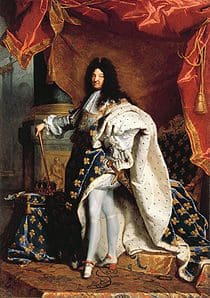
Just prior to the 1648 Peace of Westphalia, Louis XIV became King of France at age 5. His life would have an impact on the Germanna immigrants that came to Virginia in ways that we will discuss herein. In his adulthood, Louis XIV skillfully accumulated almost unfettered power in France. He benefitted from the prior actions of Cardinal Richelieu, the first minister under Louis XIII, father of Louis XIV. Richelieu stabilized the finances of the French throne through various measures, including effective tax collection. Richelieu also took action against the French Huguenots who were allowed to continue practicing their religion but were forced to give up their military weapons.
The Peace of Westphalia is viewed by some historians as the point in history marking French ascendancy in European politics and the decline of Habsburg influence.
Louis XIV built on these foundations to develop a remarkably strong government. He reorganized the French bureaucracy seeing to it that more competent individuals were assigned to the three areas he deemed key: the military, the law, and tax collection. His minister of war, Marquis de Louvois, is generally recognized as the father of the modern military. Under Louvois the army first saw a hierarchy of ranks which explains why even in the United States military we still employ French terms for ranks, e.g., sergeant, colonel, and lieutenant. The first use of military uniforms took place in the French army while Louis XIV reigned.
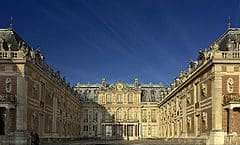
Versailles was built by Louis XIV to be a safe power base slightly away from what he considered to be the more dangerous Paris. By inviting French nobles to stay at Versailles, Louis could keep watch over them with his multitude of spies and observers. The visiting nobles were often compelled to throw lavish parties at their expense resulting in the need to borrow funds from Louis. Thus, Versailles became a great vehicle for Louis XIV to tighten his grip on French power.
Louis XIV wanted to be the dominant power in Europe which meant that war was inevitable. In war, Louis was not so successful. After losing the War of Devolution (1667-1668 over Louis XIV’s disputed claim to the Spanish throne) and the Franco-Dutch War (1672-1678 unsuccessful French attempts to control the Netherlands) Louis started the War of the League of Augsburg (1688-1697) in an attempt to claim German territory along the Rhine. It would be interesting to know if any research reflects whether any of the Germanna immigrants were veterans of this war with Louis XIV.
Before the War of the League of Augsburg, Germany (technically still the Holy Roman Empire) was ruled by over three hundred separate princes under the very diminished central power of the Holy Roman Emperor. Two German states became dominant, Brandenburg-Prussia and Austria. Frederick I was granted the title of King of Prussia and advanced his military strength to a great degree while the Hapsburgs in Austria likewise grew in strength and conquered the Ottoman Turks in 1683 at the battle of Vienna. Leopold I not only defeated the Turks but he also captured much of Hungary from the Turks.
The Germanna immigrants were undoubtedly influenced by these historical events taking place in their country before they departed. Economic factors that affected the Germans in Germany at that time were the population decreases caused by the Thirty Years War, famine, and other factors. The local rulers enjoyed extensive powers and German nobles, in an effort to keep people in their territories, began to exercise much stricter controls over the lives of the peasants. This only further exacerbated the economic woes of the country
Thom Faircloth makes the following observations :
It is highly probable that Nicholas Yeager's brother Adam, who was a soldier in the Rhineland Pfalz would have served defending the Palatinate (Pfalz) against Louis XIV. We are searching for a connection between Adam the brother of Nicholas and Adam Yeager of Woodstock who was the father of John Yeager of the Piney Woods. This Adam migrated into the Shenandoah Valley from Pennsylvania in the 1730s as part of Jost Hite's promotion of his grant in the Valley.
The claim that Louis XIV made to Rhineland Pfalz and the Saarland was this: His brother was married to the Palatine Elector's daughter Elizabeth Charlotta. She was known as Lisa Lotta and her vast correspondence from Paris and Versailles back to Heidelberg is amazing to read. She sometimes wrote 12 letters a day. She had nothing else to do because her husband was more interested in his boy friends than in getting her pregnant. However, in order to keep the brother from advancing a claim or hatching a plot to take the Sun Throne, He used Lisa Lotta's claim to the Electorate after her father's death to stake his claim and start the Augsburg war.
Finally: at the end of these many wars, which began with the 30 Years War, the population of the town of Otisheim was 10 families. Before the above cited wars it was 1,300 families. In order to populate the land with new serfs, the Princes of the Pfalz as well as Baden and Württemberg invited foreign protestants to come and farm the free lands. Otisheim is the German home of the Broyles family. They were originally known as DeBreuhl and were probably Waldensians from Waldese (pronounced Valdese) France. There is a Waldensian settlement one mile from the town hall of Otisheim. The area is also full of Huguenots, Mennonites, and Anabaptists all of whom came from Catholic countries to take advantage of the vast farmlands available in Germany.
The economy of Germany would not recover for many, many years. Even the isolated Germanna settlement in frontier Virginia must have been a welcome respite for those who carried the memories of a turbulent Germany with them to America.
The general area of the original Germanna immigrant community is now the home of the Memorial Foundation of the Germanna Colonies in Virginia which continues to do great work in promoting research into the history of colonial Virginia and the immigrants that contributed to it. Germanna Community College resides next to the Germanna Foundation Visitor Center.
The Germanna Foundation's Annual Conference and Reunion continues to grow in popularity as the historical lectures and events always enrich those who attend. The map below shows the location of the Foundation next to Germanna Community College on Route 3 between Culpeper and Fredericksburg, Virginia:
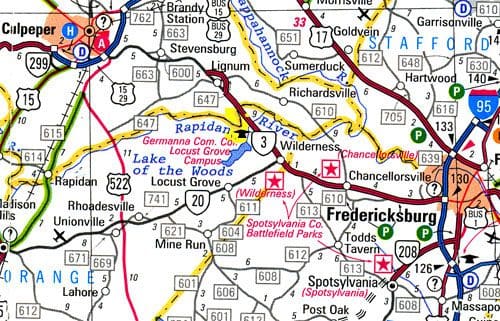
The early Germanna settlers made Virginia their home arriving from 1714 to approximately 1717. As these German immigrants became Virginians their new home was affected by events in England and in colonial America. What was going on in this new world of theirs? Much. One interesting event is that during the early years of the Germanna settlement, piracy was in its heyday in colonial waters. The famous pirate Blackbeard, aka Captain Edward Teach, roamed the coastal waters of Virginia.
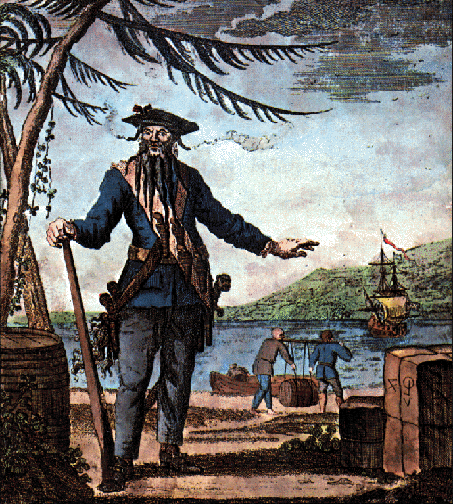
A sworn enemy of Blackbeard was Governor Alexander Spotswood. I have no documentary evidence that the Germanna settlers were affected by Blackbeard or the other pirates of that day but it is highly likely that they heard the news of the day which was greatly concerned with piracy. Thom Faircloth offers the following insights on the Germanna folk and piracy:
I would suggest that the second colony were directly affected if not by Blackbeard, then by some other pirates. Captain Andrew Tarbett had his ship and crew stolen off the coast of Virginia in 1716. He made his way to Williamsburg and testified before the governor in private session as to his misadventures. Spotswood made arrangements for Tarbett to return to England where he could report in person and plead his case.
Did Spotswood suggest that Tarbett return to Virginia with a cargo of Germans? It is truly speculation to say so but it is a good speculation given the events of 1717. Tarbett did return to England to answer charges of losing his ship, cargo, and crew. But he also had to answer charges of shortages in the casks of tobacco on the ship he commanded on his return to England.
It appears that it was common practice to cut a Hogshead of tobacco in half in order to make it fit in the certain areas of the cargo hold of a ship. Many captains were known to remove some of the tobacco from the middle of the Hogshead and keep it for their own profit. Once a Hogshead had been cut in half it was nearly impossible to account for its new weight, making it easy for the captain to practice fraud.
These court problems forced the delay of Tarbett's new ship which had taken the Germans on as cargo, not passengers. We all know the rest of the story. So it is certain that the Second Colony were deeply affected by the actions of the pirates off the coast of Virginia.
In November of 1718, Governor Spotswood met with two British Naval Captains in the partially completed Governor’s Palace in Williamsburg to discuss Spotswood’s plans to eliminate Blackbeard as a threat to the colonies. Plans were made to go after Blackbeard. Spotswood ultimately offered a reward of 100 pounds for Blackbeard, dead or alive. For more on Spotswood and the pirates in colonial days, I recommend the books Blackbeard by Angus Konstam (Konstam erroneously refers to Germanna as Germania) and The Republic of Pirates by Colin Woodard.
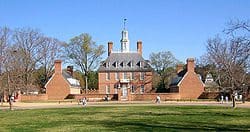
In England at this time the English government was much agitated about the threat of the Old Pretender, James Stuart, son of the deposed King James II, the last Roman Catholic King of England. (Later we will discuss whether Charles II made a deathbed conversion to Catholicism.) When James II was overthrown in 1688, it marked the Glorious Revolution of 1688 and the coronation of King William and Queen Mary. From these monarchs we gained the name of the second oldest college in America, the College of William and Mary. We also find in King William the namesake of the new capital city of the colony of Virginia, Williamsburg in 1699.
Jamestown, named after King James I, not James II, had served as the colonial capital until that time. (Note: The King James Bible is named after James I who authorized the translation.)
The supporters of James Stuart "The Old Pretender" were known as Jacobites. The effort to restore the Stuart line to the British throne became known as Jacobitism and the supporters of both James Stuart and his son Bonnie Prince Charles (see more on him below) were the Jacobites. By 1716 the threat of the Old Pretender subsided as James Stuart left Scotland and eventually ended up seeking refuge with the Pope. The threat of the Jacobites was still a concern of the Hanover dynasty as we shall see.
It is sometimes difficult for us to appreciate the connection between church and state that existed at that time. Sentiments ran strong and deep about religion as religion and politics were much more intertwined then than they are now. Protestant England often viewed Catholics as a political threat more than just a different religious expression. The Germanna immigrants were not Church of England adherents but to many in colonial Virginia it was undoubtedly felt that the Lutheranism they practiced was less of a threat.
John Blankenbaker provides this interesting Germanna connection with the Jacobite rebellion of 1715:
The Jacobite Rebellion that Michael Oddenino mentions has a Germanna connection. Two of the rebellious souls were Francis and George Hume (uncle and nephew respectively) who were captured. Their sentences were commuted (from the original death verdict). Francis Hume was sent to Virginia.
His second cousin, Alexander Spotswood, took him in but, not wanting him around Williamsburg, sent him to Fort Germanna as supervisor there. After a year or so he died and was buried along the Rapidan River. George Hume, was sent to slave ships but after a few years his freedom was purchased by Alexander Spotswood. By then, Alex was less concerned about having a rebellious soul around and George was permitted to be examined as a surveyor (by William and Mary College).
He passed and became a very well known surveyor in the frontier counties. Several of his descendants married Germanna citizens (which means the Germanna people and Spotswood share some genes).
Thom Faircloth adds:
After a stay in The Marshalsea prison in England, George Hume was sent to Virginia and placed in the care of his cousin Alexander Spotswood. He arrived in 1721, right at the end of Spotswood's tenure as Lt. Governor. Spotswood had him trained as a Surveyor at the College of William and Mary, and in 1725 he became a royal Surveyor. In 1727 he laid out the present city of Fredericksburg.
He trained George Washington and in 1749 while serving as Hume's assistant Washington laid out the town of Fairfax which later changed it's name to Culpeper. Hume died and is buried in Culpeper.
I can find no reference of his serving in a slave ship nor of Spotswood's buying his freedom.
Another interesting event in England in 1715 was the passage of the Riot Act which required any group of twelve or more individuals to disband within an hour after being ordered to disband by a magistrate who determined the group to be unruly. This is the origin of the phrase “read the Riot Act.” Also, on March 5 in 1770 when a group gathered in Boston in front of some British soldiers, the group did not expect to be fired upon since no one had “read the Riot Act” ordering them to disband within an hour. Thus, the Boston Massacre further
outraged the populace as the firing by the soldiers was viewed as even more heinous because victims were not read the Riot Act.
After the death of Blackbeard in 1718, Governor Spotswood apparently had enough time on his hands to file lawsuits against a number of the Germanna immigrants. In the 1720s a number of lawsuits initiated by Spotswood met with vigorous resistance by the German immigrants, including filing petitions for relief in Williamsburg. This suggests that during the second and third decades of their residence in Virginia the Germanna immigrants were already true Americans – dealing with lawsuits!
Other than fighting off Spotswood’s legal actions, what were the immigrants experiencing as part of life in America? In 1732, Benjamin Franklin first published Poor Richard’s Almanac which became a perennial bestseller in the American Colonies. Again, I am not aware of any direct evidence that the Germanna folk read Poor Richard’s Almanac but it is not unlikely that they were aware of and possibly read this wildly popular Almanac during the 1730s and later.
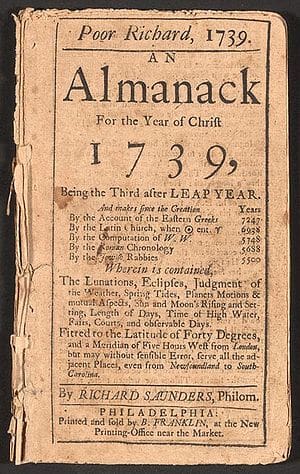
In England during the first two decades of the Germanna American experience, political issues diverted attention away from the American colonies. There was the stock company South Sea bubble which saw this English trading company reach dizzying heights in value (from 100 pounds a share to over 1,000 pounds a share). In 1720 the South Sea company experienced a stock crash due to, among other things, increasing competition. The financial crises caused by the collapse of the South Sea company was eased after Robert Walpole, considered the first British Prime Minister, revived the flagging finances by astute government management.
Robert Walpole became a leading force in English politics retaining his hold on power after the death of George I in 1727. Walpole was unexpectedly retained in power by George II in large part due to the influence of George II’s wife Caroline who greatly favored Walpole. In 1728 Caroline County, Virginia was formed from Essex, King and Queen, and King William counties named after Queen Caroline, the wife of George II.
Walpole sought to strengthen the Hanoverian dynasty and avoid controversies. These goals inspired policies which sought to cut back on naval and military expenses which would allow for lower taxes. Walpole viewed the American colonies in the context of English mercantilism. The colonies were viewed primarily as a source of raw materials and purchaser of surplus British production. To insure that the colonies served in this role, Parliament passed the Hat Act in 1732 which put restrictions on hat manufacturing and sale in America. (Note: this may have helped the health of Americans as the expression “mad as a hatter” came about as hatters did experience some mental instability which is attributed to the use of mercury in the hat manufacturing process.)
In 1733 Parliament passed the Molasses Act which placed a tax on molasses from non-British colonies. This increased the cost dramatically to the colonies. The colonies responded by wholesale smuggling to avoid the effect of this tax. Walpole didn’t vigorously enforce the Molasses tax because he did not want to expend the money, supply the forces, nor create the administrative infrastructure in the colonies necessary to such enforcement. His reasoning was that such enforcement mechanisms would result in higher taxes in order to pay for the enforcement which would cost more than the revenues gained.
A consequence of this policy was that during the 1730s and 1740s the American colonies were pretty much allowed to go their own way. This would have more severe consequences down the road when Americans faced a renewed effort at British enforcement of Parliament’s will – something the Americans were unaccustomed to and unprepared to accept.
Other events in America during this time period included the birth of George Washington in 1732 in Westmoreland County, Virginia; the birth of John Adams in Massachusetts in 1735; the birth of Patrick Henry in Hanover County, Virginia in 1736; and the birth of Thomas Jefferson in Shadwell, Virginia in 1743. These births would not have been noticed at the time by the Germanna immigrants but these men would greatly affect the lives of the Germanna immigrants and all Americans.
After the Germanna settlers had been in America for approximately twenty years, the area they settled was still considered “frontier” to the Virginia Tidewater elite. The news of that time from England would have included the War of Jenkins’ Ear between England and Spain. Perhaps this is the most novel of names given to wars as it was triggered by disputes between Spain and England in Latin America where it was alleged that Spain was torturing English sailors. Captain Jenkins claimed to have had his ear lopped off by the Spanish, which estranged ear he continued to carry with him and display. After this war began in 1739, France joined on the Spanish side and the war evolved into the War of Austrian Succession.
The War of Austrian Succession (1740-1748) involved the succession by Maria Theresa to the Austrian throne as part of the Habsburg dynasty. Frederick the Great of Prussia essentially contested her claim to the throne. France and Spain joined with Prussia while Britain and the Dutch Republic joined with Austria. With the German lands being involved in much of the fighting it would not be surprising that correspondence between our Germanna ancestors, with family and friends still in Germany, included news of this struggle.
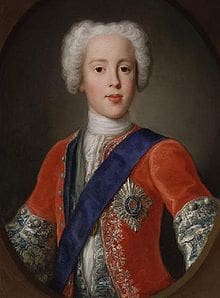
Charles Edward Stuart, “Bonnie Prince Charles” also known as “The Young Pretender,” was making his run at the British throne during this time. Remember, he is the son of the “Old Pretender” we previously discussed and the grandson of the deposed James II who was followed on the British throne by William and Mary of “Glorious Revolution” fame (and, of course, the College of William and Mary, and Williamsburg, etc.) Bonnie Prince Charles found much support in Scotland for his effort at restoring the Stuart line to the British throne.
News of this serious challenge to the Hanoverian dynasty was much discussed in the colonies and it seems likely that our Germanna ancestors would have heard news accounts of this crisis. The French were providing assistance to the Young Pretender which only underscored the threat felt by the British. Bonnie Prince Charles and the Jacobites posed a serious challenge to George II and it was dealt with most severely. During the War of the Austrian Succession, George II became the last English King to lead troops into battle, though not too successfully. George II had then turned over control of the army to his younger son William of Cumberland. This would prove to be bad news for Bonnie Prince Charles and the Jacobite cause.
In April of 1746 at Culloden Moor in Scotland, the Jacobite army under Bonnie Prince Charles met the British army under William of Cumberland. Culloden is still a much remembered event in Scotland and a well-visited tourist destination. The Jacobites were routed at Culloden by William of Cumberland who took no prisoners and earned himself the nickname of “Billy the Butcher.” The Young Pretender fled to France and this marked the effective end of the Stuart cause against the Hanoverians. It also marked the control of English law in Scotland. It even became a criminal offense to wear tartan plaid as part of the British subjugation of Scotland.
In 1748 the War of Austrian Succession formally ended with the peace treaty of Aix-la-Chapelle which essentially returned the status quo ante-bellum with a few minor exceptions. This treaty did not address trade disputes between France and England in the New World. These unsettled disputes would have a significant impact on all Americans. Also, in 1748, a protestant minister named Samuel Davies arrived in Hanover, Virginia to begin his new ministry. Samuel Davies owns an important place in Virginia history even if it is one not generally recognized. It may surprise many to learn of the life and influence of Samuel Davies in Virginia and colonial America which story we will look at next.
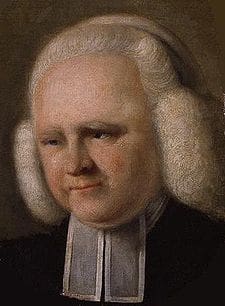
The Germanna immigrants’ early days in America coincided with the Protestant preaching phenomenon of the 18th century. In America the preachers that advocated a pious practice of Christianity, led by the heart, were called New Light preachers. This was part of the “Great Awakening” in colonial America which witnessed a fire-like spread of evangelistic preaching. One of the famous preachers of this period was George Whitefield whose rousing preaching always drew large crowds in both England and America.
Governor William Gooch, (governor of Virginia from 1727-1749, for ease of reference I use the term governor when technically it is lieutenant governor as the actual position of governor was a sinecure held by gentlemen who typically never left England) granted Presbyterians the right to worship and preach in accordance with the dictates of their conscience in Virginia in 1739.
The Anglican Church was bleeding members in Hanover County, Virginia owing to general dissatisfaction with the Anglican clergy and the doctrines espoused. These disaffected Anglicans were known as dissenters and many of this group found their way into New Light congregations. One of the Anglican ministers who saw some of his flock drift away was Reverend Patrick Henry, the uncle of Patrick Henry the great orator. There is further irony in this fact as we will explain shortly.
George Whitefield preached a sermon in Williamsburg in 1740 and printed copies of the sermon were widely distributed thereafter. Whitefield’s message generated much excitement in Virginia. The growing number of dissenters instigated concern in the Virginia colonial government and Governor Gooch summoned a group of dissenters to explain their unorthodox ways. Gooch was of Scottish Presbyterian background and after the group pledged their allegiance to the civil government he announced toleration for their practices. The dissenters experienced, as did the Germanna immigrants, some difficulty in getting and maintaining good preachers who were licensed to preach by the civil government in Williamsburg.
By 1745 the growth of dissenters in Virginia created more concern for Governor Gooch who denounced unlicensed preachers who were aggressively attacking Anglican ministers and the Anglican Church. Patrick Henry’s namesake and uncle, Reverend Patrick Henry the Anglican minister, vigorously denounced these preachers. These direct attacks by Presbyterian preachers in colonial Virginia caused the civil government to increase its oversight and enforcement of laws against such preaching. New Light congregations were left without a regular licensed preacher until Samuel Davies arrived in 1747. Davies wisely went to Williamsburg first to obtain an appropriate license from the civil authorities for his preaching.
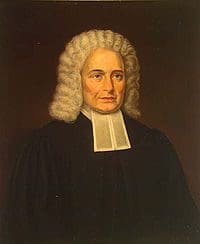
Samuel Davies became the most popular New Light preacher in colonial Virginia even traveling outside of Hanover to share his eloquent words with congregations in other Virginia locales. Patrick Henry’s mother often took young Patrick to listen to Samuel Davies’ sermons. The pulpit was not just a source of religious instruction in colonial times, it was also the source of news and political advice. During the French and Indian War, or Seven Years War, Samuel Davies regularly encouraged his congregation to support the colonial government’s cause with words such as: “Christians should be patriots. What is that religion good for that leaves men cowards upon the appearance of danger?” This attitude helped the civil government feel more favorably disposed to such non-Anglican preachers.
By many accounts, Samuel Davies was the most impressive orator of his time. Samuel Davies maintained a working relationship with the colonial government in Williamsburg impressing all who interacted with him. Davies’ oratory left his listeners not only spellbound but motivated to act in accordance with his exhortations. His reputation grew beyond Virginia and in 1759 he reluctantly left Virginia to become President of the College of New Jersey which is now known as Princeton University.
Patrick Henry, the orator and Revolutionary leader, described Samuel Davies as the example which he followed in oratory. That is high praise from one of America’s acknowledged great orators of all time. It was Patrick Henry’s skill at oratory which launched him onto the public scene in the famous “Parson’s Case.” In 1755, drought and war contributed to an unusually small tobacco crop in Virginia. Anglican clergy were paid an annual salary of 16,000 pounds of tobacco instead of hard currency which was in short supply. Before the 1755 drought, a pound of tobacco sold for approximately two pennies but after the drought the cost rose dramatically.
Virginians were faced with an impossible task of supplying the Anglican clergy with 16,000 pounds of tobacco or compensating them at the inflated value of about six cents per pound. The Virginia House of Burgesses passed the “Two Penny Act” which allowed the clergy to be paid at the rate of two pennies per pound of tobacco instead of the actual tobacco or instead of the market rate. The Anglican clergy fought this law appealing to the Board of Trade in England on the grounds that the “Two Penny Act” was passed without the typical clause which suspended its enforcement until the Crown approved it.
Governor Fauquier, who was then the colonial governor, supported the Virginia House of Burgesses further putting the Anglican clergy at odds with colonists and the local government. In London, the clergy found a friendlier audience where the “Two Penny Act” was declared void as London officials did not want to appear to be supporting the colony’s right to make laws without approval of the Crown. The issue to be resolved next in Virginia was how much were the Anglican clergy owed and from what point in time. Reverend James Maury of Louisa County sued Thomas Johnson the Louisa County collector of parish levies for his back pay. This lawsuit would have a dramatic effect on events in all of America.
At trial in 1763, Maury was represented by one of the leading lawyers in Virginia, Peter Lyons. The trial judge was Colonel John Henry, father of Patrick Henry, and brother to the Reverend Patrick Henry. Apparently, the sense that one’s honor was unimpeachable among gentlemen overrode any notion of conflict of interest Maury easily won the case on the issue of liability and the only question left was how much did Louisa County owe Reverend Maury. Thomas Johnson hired a new lawyer for the damages phase of the trial, Patrick Henry. Patrick Henry’s compelling oratory convinced the jury to award Reverend Maury one penny. Patrick Henry was thus launched onto the public scene becoming increasingly popular as a lawyer, and in 1765 he was elected to the House of Burgesses from Louisa County. The timing of his election proved to be seminal.
In our next piece we will cover some other events of this time period as well as continuing the story of the Germanna immigrants new homeland. For more information on the topics discussed in this piece, see Samuel Davies, Apostle of Dissent in Colonial Virginia by George William Pilcher and A Son of Thunder, Patrick Henry and The American Republic by Henry Mayer.
The Germanna community in Madison County, Virginia was primarily Lutheran. The Hebron Lutheran Church was their primary place of worship. Ironically, it was Joseph Oddenino who painted the interior of the Church that many of the Germanna families worshipped in. Mary Elizabeth Delph then married Joseph's son Francis Lawrence Louis Oddenino who came to Virginia to be with his father.
The Germanna community enjoys a rich history and researcher par excellence, John Blankenbaker, shares his research on the German families' history both in the new world and the old world.
For more background on the origin of the Germanna immigrants, we are again indebted to our cousin, John Blankenbaker (the red highlights are my own to demonstrate an ancestor in our tree and I have added the links):
Nr. 326:
On the 24th and the 25th of April, the Pennsylvania chapter of the Palatines to America held their spring conference with Dr. Alfred Hans Kuby as the featured speaker. Dr. Kuby lives in Edenkoben, in the Palatinate. He is known as a minister, historian, and genealogist. In one talk, he gave glimpses of life in Edenkoben during the 17th and 18th centuries.
Around 1670, Edenkoben had 500 inhabitants. As a result of the Thirty Years' War the population had been greatly reduced from earlier numbers and it was many decades before the population was rebuilt. One way in which the population was rebuilt was by emigration from other Germanic regions.
Dr. Kuby documents that between 1653, shortly after the end of the war, and 1699, there was a total of 50 families who came from Switzerland to Edenkoben. (One of these families has a Germanna name, Amberger, but I would not claim there was any relationship to the Germanna family.)
In 1715, three families came from French regions, one family came from Flemish regions, one from Italy, and one from another German region. There was therefore a wide diversity of people living in Edenkoben.
In the next year, the pattern was similar. Perhaps there is a connection to the large number who emigrated from German regions in 1717, as these movements of people may have indicated very unsettled conditions.
The ruler of the Palatinate was Catholic and that was the favored religion. If one wanted to hold a public office, one must be a Catholic; however, a majority of the people were Reformed and a smaller number were Lutheran. There were difficulties for the Protestants but the climate was not oppressive. The Protestants had to observe the Catholic holy days. They could not do any work on these days, not even washing clothes at home. If they were caught, they were fined, with the fine going to the Catholic Church.
We now know that many of our Germanna people have origins outside the region from whence they migrated to America. For example, Christopher Zimmerman's ancestors came from the Canton of Bern in Switzerland. As you climb the Willheit tree, you find Swiss origins for some of the people. Many of the Germanna families had ancestors who had migrated into Germanic regions from other places. The Blankenbakers, for example, started on a path that originated in Austria and stopped first in Bavaria before moving west, close to the Rhine River, on lands of the Bishops of Speyer (now Baden). The Harnsbergers appear to have emigrated directly from Switzerland to Virginia but one cannot be sure that they did not do this is a two-stage move. They may have moved to a "German" region but left almost immediately for the New World.
For more detail, click on this link to John Blankenbaker's Germanna history.
Here is a map of Germany showing its location in Europe and the state divisions wihin Germany. Most of the Germanna immigrants came from the western and southwestern area of Germany often called the Palatinate:
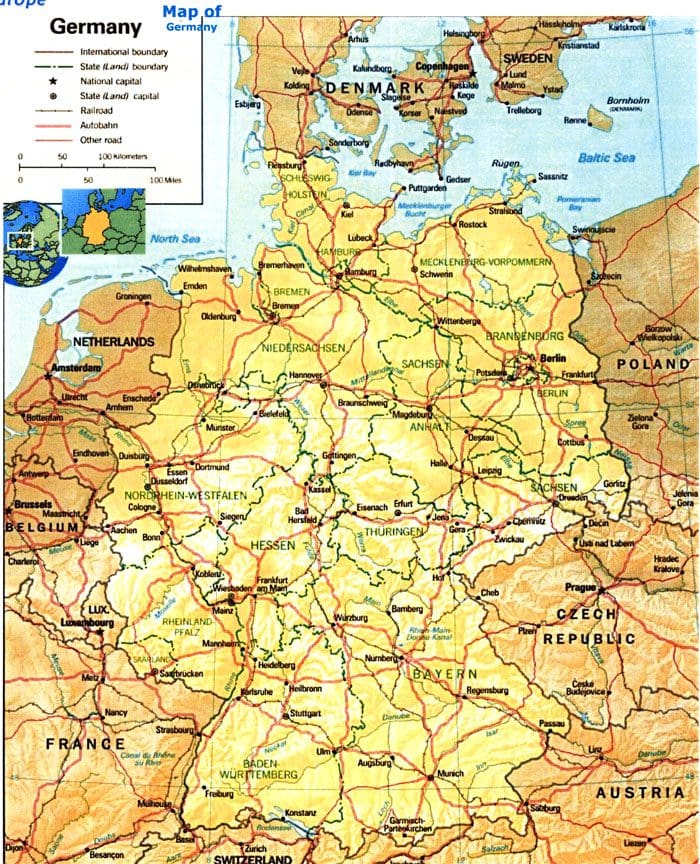
Below is a map of Virginia to help better locate where the Germanna immigrants settled which was primarily what is now known as the counties of Madison, Culpeper and Fauquier.
Map Courtesy of Digital Map Store
Germanna lines are represented by all the families in the chart below, DELPH, CASTLER, SNYDER, SCHNELL, COOK, REINER, RAZOR, AND BUTLINGER:
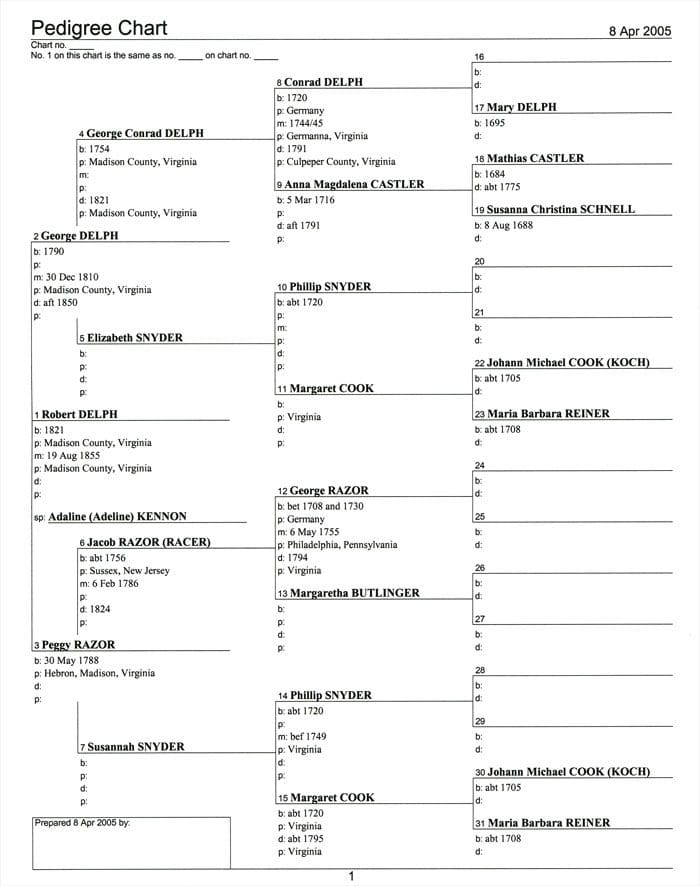
Here is a little peek at Michael Cook (Johann Michael Cook) from John Blankenbaker:
The two thousand and eighty-second note in a series on the Germanna Colonies
In the history for the London Lutheran pastors, Smith and Hold said the group began (in Virginia) with divine services by reading the divine word, singing and praying, etc. I have to interpret this as starting with their arrival and settlement in Virginia before they moved to the Robinson River Valley.
Eight years prior to 1734, namely 1726, the group raised the money to send Cyriacus Fleshman and John Motz to London to pursue the question of a pastor. There had been an exchange of letters before this without any real communication taking place. On both sides of the Atlantic, there was a claim that no letters had been received. Initially, the group was going to send Fleshman and Cook (this is usually what is reported in the histories) but they changed their plans and sent Fleshman and Motz. We know that Fleshman returned to Virginia but it is not certain that Motz returned to Virginia. Two things could have happened, he might have died on the return or he might have returned to Germany.
The group thought that Spotswood had promised them that if they had a minister within ten years that they would be exempt forever from the Anglican church parish taxes. This was probably a misunderstanding on their part.
The group wanted to obtain land which was clustered around a central location where they could build a church. This forced them to go to the mountains. The land between Germanna and the mountains had largely been taken up by others such as Spotswood, Beverley, and Carter. They could meet their physical nourishment in their new homes but they were not able to trade with the Tidewater communities because of the distance. Incidentally, they were in error about the distance from Germanna to the mountains. Their claim of 40 English miles is excessive.
They immediately built a meeting house in the midst of their new settlement. It appears that they moved in 1725 so the chapel dated from this year. They appear to have held a generous number of church services but of course without a pastor and the sacraments. Michael Cook was probably one of the principal readers which may be the reason that he did not go to London.
As the history moves into the arrival of Stoever in the community, we would like to know how this came about. Apparently, but we do not know, he was traveling through from North Carolina to Pennsylvania. He may have been aware there was a German-speaking community here and decided that he would spend one of his nights here. One thing led to another especially when the elders in the community found that he had a reasonably good education. The lack of ordination could be cured, it was hoped, by finding someone in Pennsylvania who could ordain him. On this point he was moderately successful. He was ordained but may have felt that the credentials of the man ordaining him were weak.
John Blankenbaker also shares some photos he has taken of Schwaigern, Germany which was the hometown of Michael Cook and other Germanna immigrants -- click here to see those photos.
Most of the Germanna ancestors in the Oddenino family tree were part of the Second Colony immigrants of 1717. Again, thanks to John and Eleanor Blankenbaker for a map of the areas in Germany from whence these families came.
When Michael Bazzle married Nany Elizabeth Utz, the Germanna lines entered the family tree in full force with the families UTZ, MEYER, CRIGLER, WAYMAN, WEIDMAN, HERLING, JUNG, CARPENTER, (ZIMMERMAN), WEAVER, HUFFMAN, FINKS, FISHER, KAIFER, KERCHER, BLANKENBAKER, WILHEIT, CHRISTLER, BROYLES, GAAR, SCHON, et. al.:
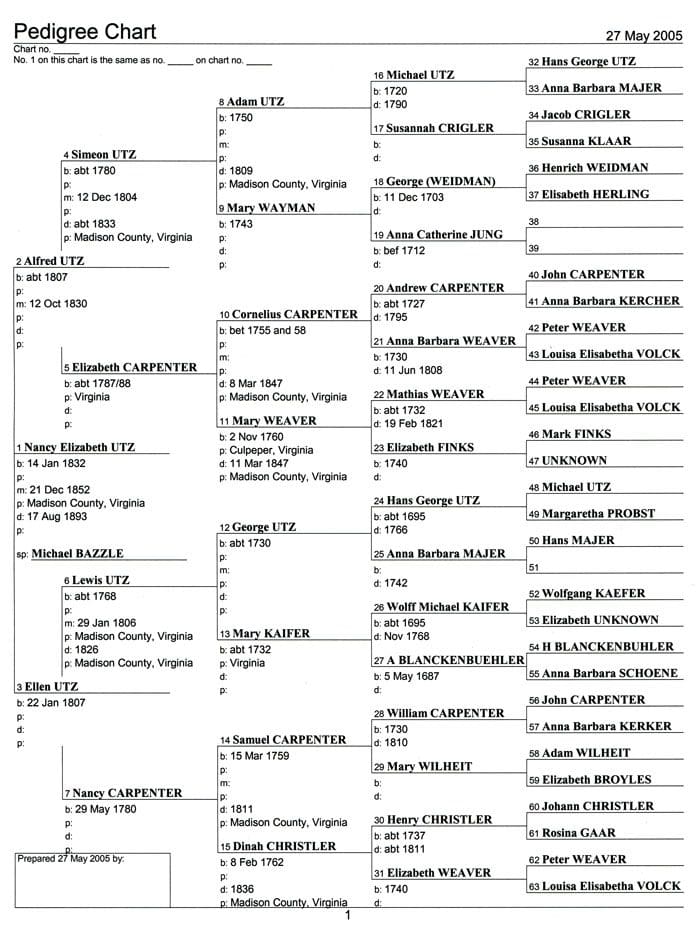
More insights from John Blankenbaker on these family connections:
In the early 1730's, the Theobald Christler [Johann Theobald Christler] family moved to Orange Co., Virginia (becoming later Culpeper and Madison counties). Theobald married Rosina Gaar, whose family also moved at about the same time from Pennsylvania to Virginia. ("Bender", in Germany, became "Painter", in America, usually.)
The family of Theobald and Rosina was quite large, eleven children, and ten of these have marriages to an assortment of Germanna families such as Weaver, Broyles, Carpenter, Smith, Crigler, Wayland, Wilhoit, Clore, and Thomas.
Nancy Carpenter was the second wife of Lewis Utz. Lewis' first wife was Mary Carpenter, the aunt of Nancy Carpenter. Let's take another look from the perspective of Nancy Carpenter's family tree (more research is needed to confirm some of this data):
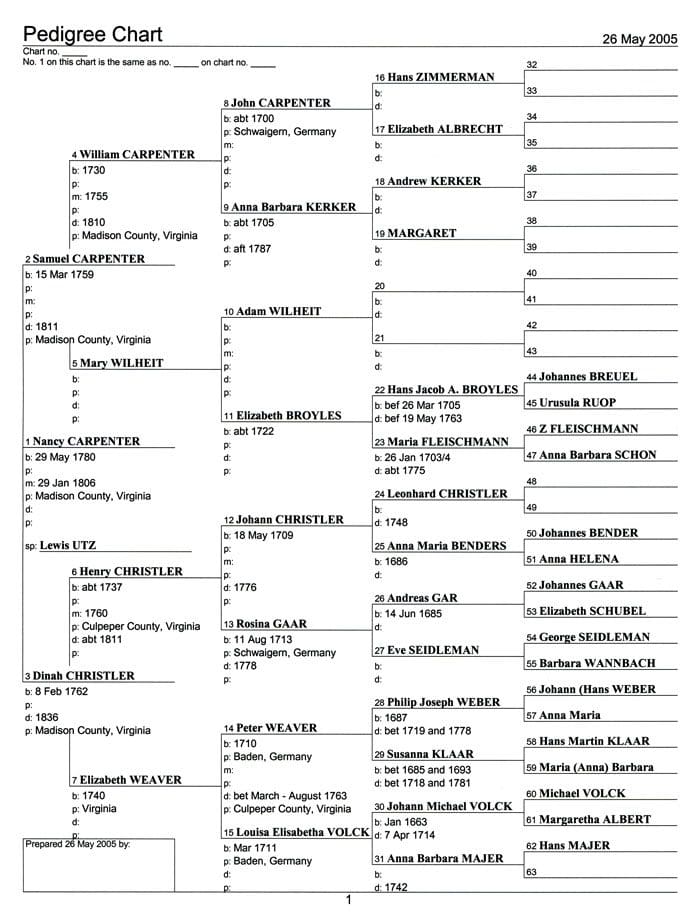
One of the ancestors in this line is Susanna Klaar about whom we can thank John Blankenbaker for his work on Susanna Klaar for some insights into this grand Germanna lady. For more on the Klaar (Clore) family history, click here for the website of Cathi Clore Frost
For more details on the Clore family, order Cathi Clore Frost's excellent new publication on The Michael Clore Family in Virginia which is offered by the Germanna Foundation as Germanna Record No. 16


